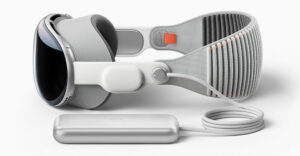I’ve been playing with the new Meta Quest 3 headset for the last several days, and I’m impressed.
This headset is much better than Meta Quest 2 because it begins to address some of the intrinsic problems with virtual reality (VR) technology.
It may need one or two more versions to truly hit the sweet spot for where this technology needs to be, and we are still lacking a “killer app or game” that will drive people to the platform.
This week, let’s talk about what Meta Quest 3 got right, what it will need to improve, and what a killer app or game for this device might look like.
We’ll close with my product of the week, a set of smart adjustable-focus glasses from 32°N.
Meta Quest 3 Improvements
Meta Quest 2 had several advantages over prior VR efforts. It was untethered and wireless, so you didn’t trip or become tangled in a cord. It wasn’t bad-looking, though it was still a bit large for my taste.
While Quest 2 wasn’t that comfortable, you could buy aftermarket head straps that improved the comfort significantly, and it had several games like Beat Saber that I liked to play for 30 minutes or more (typically, using VR for more than 30 minutes risks motion sickness).
Issues with the Quest 2 headset were its limited field of view. Its low resolution often made it feel like you were looking through a screen, and it lacked any Halo- or Mario Bros.-class games or entertainment. Although you could see out of the device using built-in cameras, the view wasn’t great, so forming a safe region to play with the headset was a problem.
Meta Quest 3 feels like a new-generation headset. It has a much wider field of view, is more comfortable even without the third-party straps, looks better on your head (though I’d prefer it to be black instead of white), and its sound is night-and-day better than Quest 2.
The cameras in the Quest 3 device are much better than the Quest 2 cameras. It sets up a safe place to play easily and automatically, though I need to clear more room in my office because the space it gave me would make a closet feel large.
Meta Quest 3 Outshines Its Predecessor
While I enjoyed Quest 2, I like Quest 3 much better. Meta has significantly improved the user interface and increased the number of titles available on the headset. However, I’m still gravitating back to the games I enjoyed on Quest 2.
Meta Quest 3 provides a much-improved experience partially as a result of using Qualcomm’s more advanced Snapdragon XR2 Gen 2 platform, which is significantly more powerful than the Gen 1 platform used in Meta Quest 2.
Quest 3 also shows your hands more realistically, making it likely that there will be an increasing number of new games that allow you to drop the controllers and just use your hands. Finally, Meta Quest 3 has optional straps and face surrounds so that you can customize some of the colors used on the device.
Anticipating Meta Quest 4
In about a year, I expect another version of this headset will address the remaining shortcomings in Meta Quest 3. Meta Quest 4 should have even better cameras so that you can see your surroundings in full fidelity.
Meta Quest 2 was like looking through heavy fog. Quest 3 is like looking through a light fog. Quest 4 should be like looking through a window, and it should also have improved processing power so you can better blend the virtual with the real, create a more compelling visual experience, and be more successful at preventing injury due to obstacles in the room around you.
Wrapping Up: The Ultimate Holiday Pick for VR Enthusiasts?
Meta Quest 3 is easily the best VR headset currently in the consumer market. It is sleek, reasonably priced, provides a good experience, and has a lot of mostly Quest 2 (some updated) content for the device.
You get a free game, Asgard’s Wrath 2, but that game won’t come out until December, so I haven’t tried it yet. Meta Quest 3 also comes with a six-month free trial for the Meta Quest+ VR gaming subscription as a teaser for the service.
Unlike game consoles that enable multiple players by default, VR games tend to be individual experiences, which means if you have multiple kids, each one will need a headset. Purchasing multiple headsets can get expensive quickly, at $500 to $650 for models with additional memory. However, it would keep at least one kid out from underfoot and doesn’t tie up the TV like a game console will.
In addition, playing a VR game is far more aerobic than playing a typical game on a console, making it potentially healthier for adults and children. For the right kid or adult, this could be a perfect gift, but I’d make sure that there was a VR game they wanted to play first. I’ve enjoyed Beat Saber and Resident Evil 4, which is much more immersive with the new headset.
Here is a video on some of the most immersive zombie games on the headset. My taste in games has me favoring the Iron Rebellion VR Mech game that came out for Quest 2; this game wasn’t updated for Quest 3 but plays really well on the new headset.
You want to make sure there is a game that the recipient of this headset wants to play. Otherwise, it just won’t get much use post-holiday use.
If you have folks over for the holidays, you might want to get this to entertain your guests. Just watching someone play with a VR headset can be entertaining all by itself, and it does have a certain wow factor for those who have never played VR games before. But without a truly must-have game, this is an option for someone who wants the device.
As noted above, it could liven up your holiday celebrations, but it isn’t yet in the same class as a game console with a following, though it’s getting closer with every update. So no, for most, it won’t be the must-have gift, but it could be for the right kid or adult. Before purchasing, check with the intended recipient to ensure they have an interest in VR and that there’s a specific game they’d be excited to play, and take it from there.

32°N ‘Smart’ Sunglasses
Most smart glasses focus on providing information in the related display, but I’ve always thought that genuinely smart glasses should first tackle fundamental eyewear challenges: adjusting for light and focus.
The 32°N sunglasses do the latter and allow you to shift from just dark glasses to dark reading glasses with a swipe of the hand or a touch to the earpiece.

32°N adaptive focus sunglasses are available in four frame colors: black, caramel, clear, and tortoise.
(Image Credit: 32°Nglasses)
They don’t provide any data. They’re just glasses that morph into reading glasses, but if you use reading glasses like I do and often find yourself unable to read the message on the dash of your car or don’t have your reading glasses with you but need to read smaller text, these could be the solution for you.
There are some things I’d like to see fixed.
For instance, even in reading mode, the glasses maintain their tint. In a dimly lit restaurant, enhancing text legibility doesn’t help if you can’t see to begin with — especially when the dark glasses exacerbate the low-light conditions. So, integrating adaptive optics that automatically lighten in dark conditions would make these a ton more useful than they currently are.
If they also showed data, like more common smart glasses, they’d be an ideal solution. We aren’t there yet, but for people like me who wear dark glasses almost all the time (especially those of us with blue eyes) and need to carry reading glasses, these allow you to read small type more conveniently without taking multiple pairs of glasses.
Be aware that you must load the related app and go through a process to adjust them for your eyes to work. This step is quick, but the glasses will not work without that calibration — something I learned the hard way.
At around $850, they aren’t a cheap date, but for those of us who need a flexible solution, they do the job and are worth the investment.
While these glasses are available with custom lenses, I found the generic version worked just fine for me. My only other observation is that they look a bit too much like the old 3D glasses that used to come with 3D TVs. They could be more stylish. But these are generation-one products, and I expect them to get better as they evolve.
The 32°N adaptive reading sunglasses solved a problem for me, so they are my Product of the Week.
Transform your view in a swipe — get 32°N Sunglasses today.























































